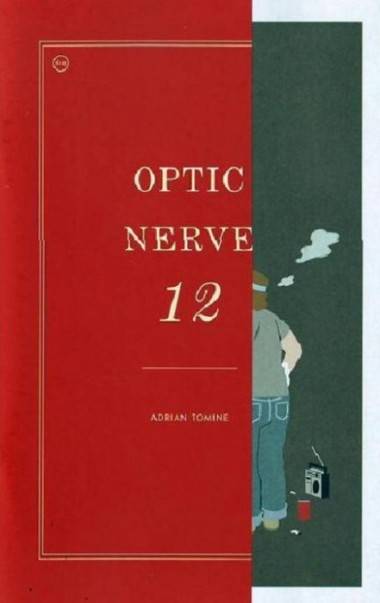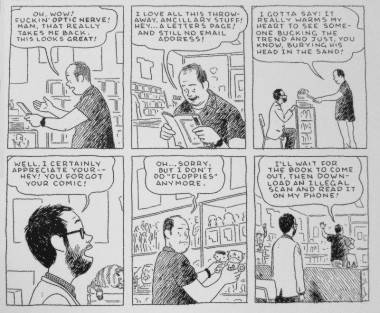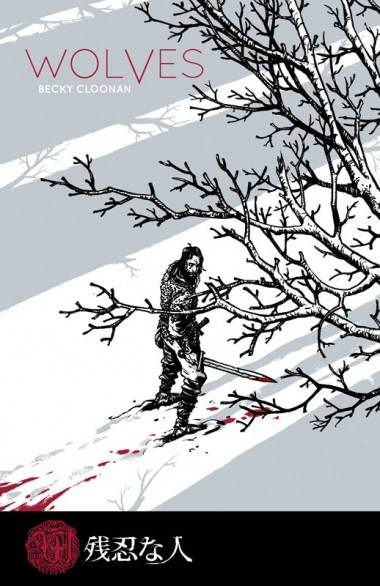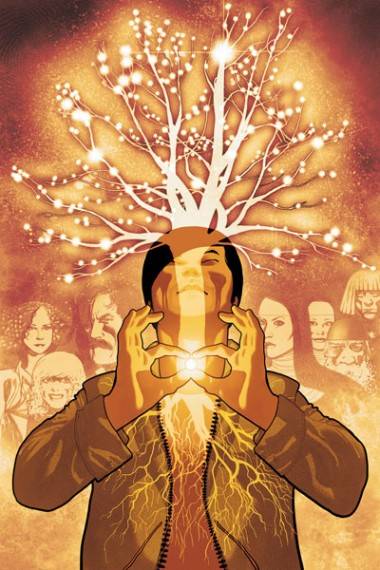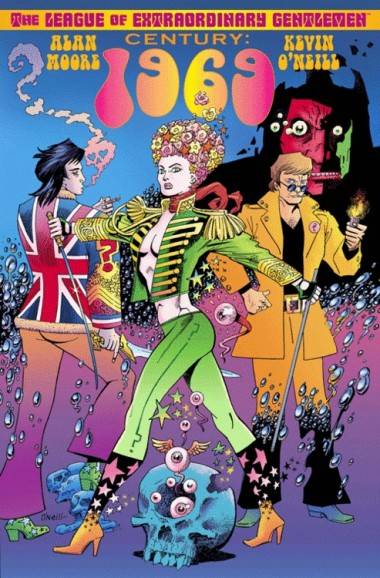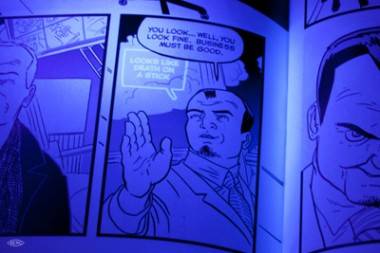Comic book reviews – Optic Nerve 12 and more
– by Ryan Ingram
The idea of comic books as floppy pamphlets seems to be disappearing.
Spinner racks are dead and gone, and now when you think comics, it’s mostly hardcover “graphic novels” on bookshelves, or comics as just another thing to download. There’s no better epitaph for the current state of the floppy comic book format than in Adrian Tomine’s newest issue of Optic Nerve, released last week.
The back cover features a bonus autobiographical strip where Tomine is jokingly referred to as “the last pamphleteer”, as he fights to publish a good, old-fashioned floppy indie-comic, complete with a visit to a hurting comic store.
While all his colleagues are signing plush books deals, Tomine offers glimpses of the futility and frustration of putting out a single comic, while also showing the thrills of working in an “antiquated format.”
In honor of a dying form — or the rise of a growing novelty – here are five “floppies” worth checking out:
Optic Nerve 12 (Drawn & Quarterly) – While the last two-pages offer a glimpse of a dying format, the issue itself is a strong statement to the power that a single comic book can still possess. While the letter pages and the bio-strip are nice touches, Tomine plays with the format in the two feature short stories.
Drawn like it belongs in the newspaper funnies, “Horitisculpture” follows a sad-sack artist tortured by his desire to create unique art installments combining sculpture and plants (hence the title). Each strip’s punchline is squirm-inducing, and although Harold is drawn with cartoony simplicity, his artistic desperation is selfish, heartbreaking and very real.
The second story, “Amber Sweet”, follows the fractured life of a woman constantly mistaken as a famous Internet porn star, featuring Tomine’s elegant lines, beautiful colors, and yeah, sadness.
You could make an argument (or at least I can try) that the three stories in Optic Nerve 12 are focused on obsession with unconventional (and debatable) art; whether it’s creating “hortisculpture,” being haunted by living under the shadow of an Internet porn star or the potential absurdity of creating a pamphlet-style comic book in the 21st century. (Order Optic Nerve # 12 here.)
Wolves (Ink and Thunder) – Wolves is a beautifully crafted mini-comic self-published by artist Becky Cloonan, whose work you should really know from DEMO. While Wolves is a quick twenty-page read, Cloonan makes every panel count, and the end result is a short fantasy-horror tale that’s big on dark, raw atmosphere, werewolves and ultra-violence. There’s also a sharp twist that will stick through your heart after you put the comic down. (Order Wolves here.)
Xombi (DC Comics) – Before DC re-launched their entire universe, they were quietly putting out one of the few superhero comics worth picking up on a monthly basis. Frazer Irving’s pop-gothic art – and his nightmare-inducing use of neon colours – is worth the price of admission alone. Luckily writer John Rozum provides plenty of weird ideas for Irving to bring to life.
Originally created in the ’90s by Dwayne McDuffie (who passed away earlier this year), Xombi is about David Kim, a scientist who gets infected with nano-machines that keep him perpetually living in the prime of his life. So, it’s pretty much that same old story, about an immortal guy that hangs out with super-powered nuns, talking coins, and mummies made of hornet’s nests, as he gets half-eaten by a god-like lion and travels to flying skull castles. You know what I’m talking about.
Xombi reached six issues before the plug was pulled, and all of them are worth hunting down in floppy-form if you can find them before the collected edition comes out next year.
The League of Extraordinary Gentlemen: Century: 1969 (Top Shelf) – The League of Extraordinary Gentlemen began as a mash-up of Victorian literature, cleverly stitched together by Alan Moore and Kevin O’Neill. The series was a place where the monstrous Mister Jeckyll could take on H.G. Wells’ invading martians from War of the Worlds, while Doctor Moreau was off creating anthropomorphic mutants that look a lot like the characters from The Wind in the Willows.
But since 2007’s ”Black Dossier”, and now with each new volume of the Century trilogy, Moore is conducting an even madder experiment, attempting to weave the entirety of 20th century fiction – movies, television, comics and music – into a cohesive universe and timeline. The latest volume follows the immortal trio – Mina Murray, Allan Quartermain, and the sex-changing Orlando – into London’s swinging ’60s.
There’s a lot of fun to be had in the slim volume, which is built around a typical ’60s story, complete with an acid trip at a free-loving music festival. (In the LOEG-verse, Hyde Park is named after the heroic Mr. Hyde.)
Kevin O’Neill’s delicate line work successfully makes the jump from 19th Century England to LSD-inspired psychedelia, even though it’s sometimes distracting trying to figure out if O’Neill is indulging in the “free love” decade, or just really, really into drawing nipples.
With copyright restrictions, there’s definitely a limit as to what Moore can incorporate into his overwhelming sandbox, and it feels almost like a cheat that two of the new characters are not-so-well known fictional characters, but analogues for real people (Mick Jagger and Aleister Crowley), and also that another character is a weird composite of two gay gangster characters played by actor Ian McShane. But there are still enough legit references to keep you busy checking Jess Nevin’s annotations and the Mindless Ones commentary for hours and hours afterwards.
SVK (Berg) – SVK is simultaneously a throwback novelty and completely futuristic, and it’s everything you could want from a floppy.
With surveillance and terrorism at the center of the story, SVK is about a detective-type trying to track down a prototype piece of technology that lets people’s thoughts be seen. Instead of relying on the comics’ thought-bubble approach, SVK is printed with UV ink and it comes with a credit card-sized “torch” that reveals characters’ thoughts (and other goodies) on the page in blacklight.
It’s written by Warren Ellis, so there’s the expected doses of grumpy ass-kicking and great one-liners. Artist Matt “D’Israeli” Brooker is a solid talent, providing sleek art with just enough detail. The story wouldn’t be out of place in William Gibson’s recent trilogy, which makes the Vancouver-based author’s foreword to the book very fitting.
Another part of the SVK fun is the filler material, including 60’s-style comic book ads, except instead of sea-monkeys and 3-D glasses, there’s The Mindhub that can hook into your brain directly into the Internet, and a slew of other great retro-future gags. SVK is a slick package and it definitely comes at a high price. (It cost $30 to buy and ship to Vancouver. Order here.)

